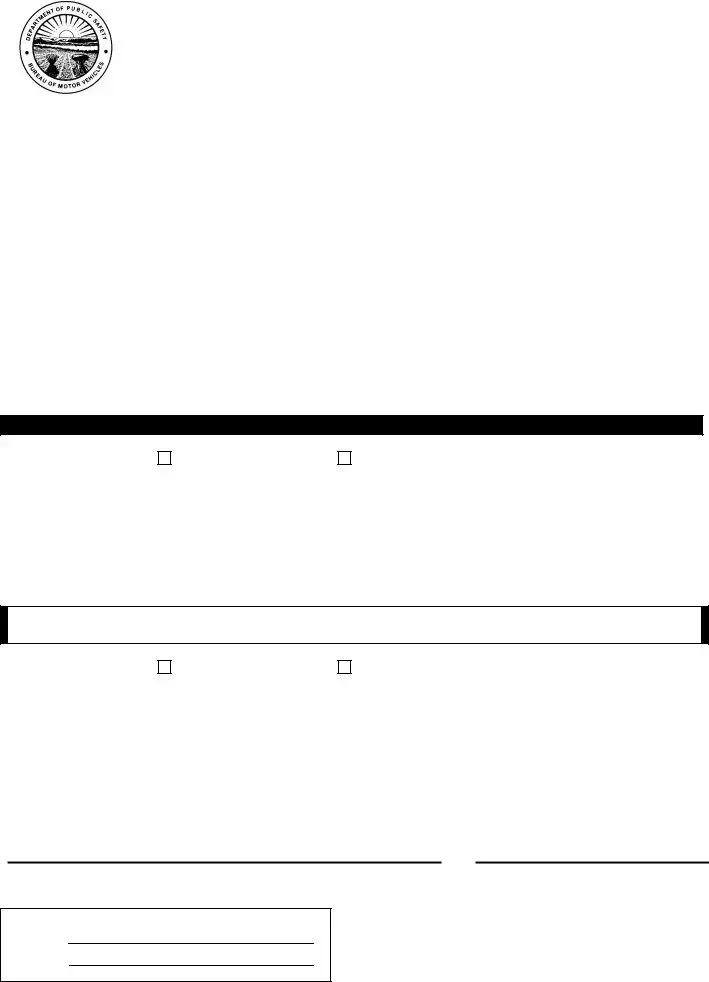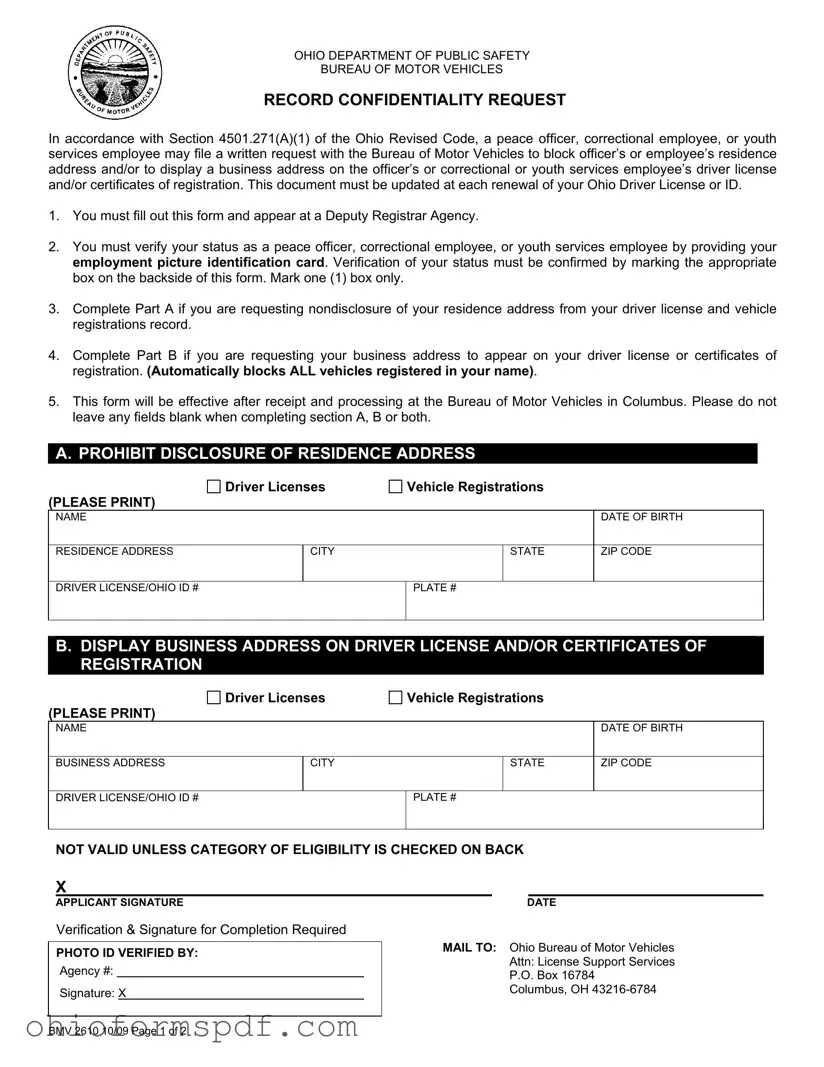
OHIO DEPARTMENT OF PUBLIC SAFETY
BUREAU OF MOTOR VEHICLES
RECORD CONFIDENTIALITY REQUEST
In accordance with Section 4501.271(A)(1) of the Ohio Revised Code, a peace officer, correctional employee, or youth services employee may file a written request with the Bureau of Motor Vehicles to block officer’s or employee’s residence address and/or to display a business address on the officer’s or correctional or youth services employee’s driver license and/or certificates of registration. This document must be updated at each renewal of your Ohio Driver License or ID.
1.You must fill out this form and appear at a Deputy Registrar Agency.
2.You must verify your status as a peace officer, correctional employee, or youth services employee by providing your employment picture identification card. Verification of your status must be confirmed by marking the appropriate box on the backside of this form. Mark one (1) box only.
3.Complete Part A if you are requesting nondisclosure of your residence address from your driver license and vehicle registrations record.
4.Complete Part B if you are requesting your business address to appear on your driver license or certificates of registration. (Automatically blocks ALL vehicles registered in your name).
5.This form will be effective after receipt and processing at the Bureau of Motor Vehicles in Columbus. Please do not leave any fields blank when completing section A, B or both.
A.PROHIBIT DISCLOSURE OF RESIDENCE ADDRESS
Driver Licenses
(PLEASE PRINT)
NAME |
|
|
|
DATE OF BIRTH |
|
|
|
|
|
RESIDENCE ADDRESS |
CITY |
|
STATE |
ZIP CODE |
|
|
|
|
|
DRIVER LICENSE/OHIO ID # |
|
PLATE # |
|
|
|
|
|
|
B.DISPLAY BUSINESS ADDRESS ON DRIVER LICENSE AND/OR CERTIFICATES OF REGISTRATION
Driver Licenses
(PLEASE PRINT)
NAME |
|
|
|
DATE OF BIRTH |
|
|
|
|
|
BUSINESS ADDRESS |
CITY |
|
STATE |
ZIP CODE |
|
|
|
|
|
DRIVER LICENSE/OHIO ID # |
|
PLATE # |
|
|
|
|
|
|
NOT VALID UNLESS CATEGORY OF ELIGIBILITY IS CHECKED ON BACK
X
Verification & Signature for Completion Required
PHOTO ID VERIFIED BY:
Agency #:
Signature: X
MAIL TO: Ohio Bureau of Motor Vehicles
Attn: License Support Services
P.O. Box 16784
Columbus, OH 43216-6784
BMV 2610 10/09 Page 1 of 2
C.Applicable to Peace Officer, Correctional or Youth Services employee described as follows
I qualify as a Peace Officer, Correctional Employee or Youth Services Employee as checked below:
1. A deputy sheriff, marshal, deputy marshal, member of the organized police department of a township or municipal corporation, member of a township police district or joint township police district police force, member of a police force employed by a metropolitan housing authority under division (D) of section 3735.31 of the Revised Code, or township constable, who is commissioned and employed as a peace officer by a political subdivision of this state or by a metropolitan housing authority, and whose primary duties are to preserve the peace, to protect life and property, and to enforce the laws of this state, ordinances of a municipal corporation, resolutions of a township, or regulations of a board of county commissioners or board of township trustees, or any of those laws, ordinances, resolutions, or regulations.
2. A police officer who is employed by a railroad company and appointed and commissioned by the governor pursuant to sections 4973.17 to 4973.22 of the Revised Code.
3. An undercover drug agent.
4. Enforcement agents of the department of public safety whom the director of public safety designates under section 5502.14 of the Revised Code.
5. An employee of the department of natural resources who is a natural resources law enforcement staff officer designated pursuant to section 1501.013, a park officer designated pursuant to section 1541.10, a forest officer designated pursuant to 1503.29, a preserve officer designated pursuant to section 1517.10, a wildlife officer designated pursuant to section 1531.13, or a state watercraft officer designated pursuant to section 1547.521 of the Revised Code.
6. A police officer who is employed by a hospital that employs and maintains its own proprietary police department or security department, and who is appointed and commissioned by the governor pursuant to sections 4973.17 to 4973.22 of the Revised Code.
7. Ohio veteran’s home police officers designated under section 5907.02 of the Revised Code.
8. A state university law enforcement officer appointed under section 3345.04 of the Revised Code or a person serving as a state university law enforcement officer on a permanent basis on June 19, 1978, who has been awarded a certificate by the executive director of the Ohio peace officer training council attesting to the person’s satisfactory completion of an approved state, county, municipal, or department of natural resources peace officer basic training program.
9. A special police officer employed by the department of mental health pursuant to section 5119.14 of the Revised Code or the department of mental retardation and developmental disabilities pursuant to section 5123.13 of the Revised Code.
10. A state highway patrol trooper.
11. Correctional employee of the department of rehabilitation and correction who in the course of performing job duties has or has had contact with inmates and persons under supervision.
12. Youth services employee of the department of youth services who in the course of performing job duties has or has had contact with children committed to the custody of the department of youth services.
13. An officer, agent, or employee of the state or any of its agencies, instrumentalities, or political subdivisions, upon whom by statue, a duty to conserve the peace or to enforce all or certain laws is imposed and the authority to arrest violators is conferred, within the limits of that statutory duty an authority, an investigator of the bureau of criminal identification and investigation as defined in section 2903.11 of the Revised Code.
14. A member of a police force employed by a regional transit authority under division 306.35 of the Revised Code
(PLEASE NOTE THAT IF YOU ARE A PEACE OFFICER BUT NOT LISTED ABOVE, YOU DO NOT QUALIFY. ONLY THOSE LISTED ABOVE ARE ELIGIBLE UNDER THIS LAW.)
My Peace Officer, correctional or youth services employment status has changed, and I no longer qualify to request nondisclosure of my residence address or display of my business address on my driver license or certificates of registration.
I am an eligible Peace Officer, correctional or youth services employee but no longer wish to request nondisclosure of my residence address or display of my business address on my driver license or certificates of registration.
X
BMV 2610 10/09 Page 2 of 2


